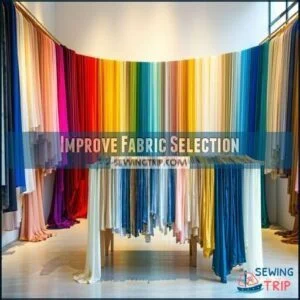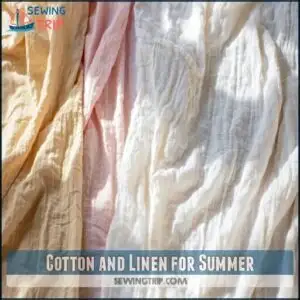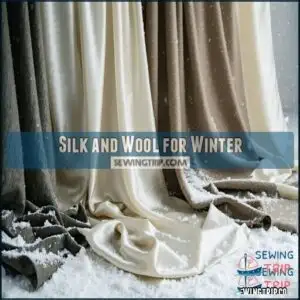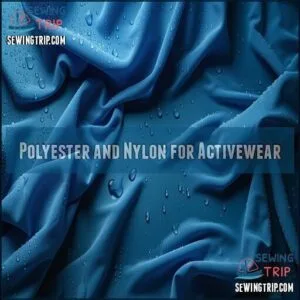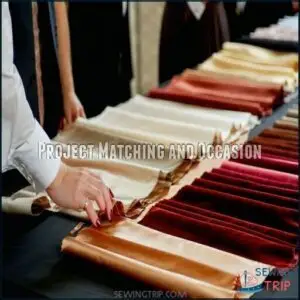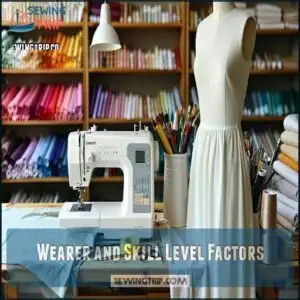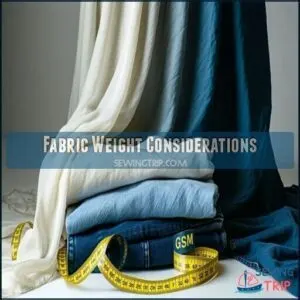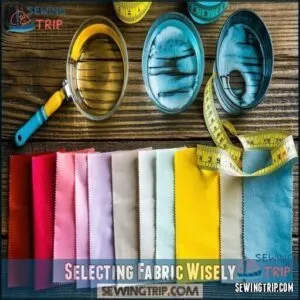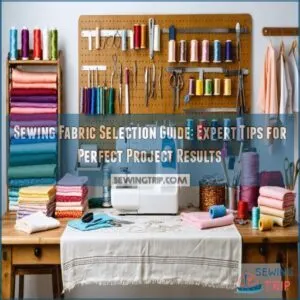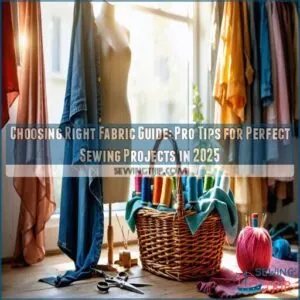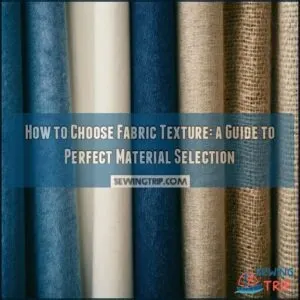This site is supported by our readers. We may earn a commission, at no cost to you, if you purchase through links.
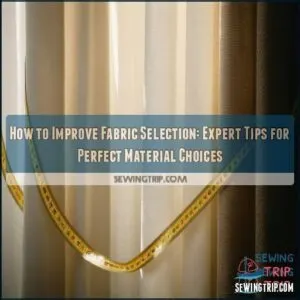
You’ll want to match fabric properties to your project needs: drape for flowing garments, structure for custom pieces.
Don’t skip pre-washing samples to test for shrinkage and color fastness. Learn to identify grain lines and check for stretch in the right directions.
Consider practical factors like care requirements and seasonal appropriateness. Even experienced crafters sometimes bring home the wrong fabric—a small swatch can save you from big project headaches.
The difference between "good enough" and "perfect" often lies in those subtle textile characteristics.
Table Of Contents
Key Takeaways
- You’ll make better fabric choices by understanding material properties like drape, weight, and texture – quality fabrics have substantial weight and consistent weave patterns.
- You should match fabric to your specific project needs – consider the occasion, weather conditions, and your skill level before making a final selection.
- You can prevent costly mistakes by pre-washing samples to test for shrinkage and color fastness before cutting your pattern pieces.
- You’ll need to evaluate fabric performance metrics including durability, breathability, and sustainability to ensure your finished projects maintain their quality over time.
Fabric Selection Basics
Choosing the right fabric starts with understanding its fibers and how they perform. From natural to synthetic options, knowing their strengths helps you select materials that suit your project perfectly.
Natural Fibers and Characteristics
Natural fibers add comfort and style to fabric selection.
Cotton offers absorbency, making it great for daily wear. Linen excels in breathability, keeping you cool on hot days.
Wool provides natural insulation for cozy winters, while silk’s luxurious drape elevates elegance.
Plus, plant dyes enhance natural fibers with eco-friendly hues. Knowing fabric characteristics helps you match fiber types to your project perfectly, and understand the value of natural fibers and their eco-friendly aspects.
Synthetic Fibers and Properties
Synthetic fibers bring durability and versatility to the table.
Polyester’s properties include resilience and wrinkle resistance, perfect for busy lifestyles. Nylon’s durability makes it a favorite for activewear and outerwear.
Acrylic benefits include being lightweight and cozy, mimicking wool, while rayon offers unmatched softness for flowing garments.
Microfiber shines in home essentials with its stain-resistant functionality. Balance fabric properties wisely!
Blended Fibers and Benefits
Blended fabrics combine the best traits of multiple fiber types, like cotton’s comfort with polyester’s durability.
Fiber blending enhances performance, making materials versatile for various projects.
Innovative fiber fusions offer unique textures and easy care.
With blend performance testing, you can confirm quality.
Blend cost analysis helps balance budget and longevity, letting you choose wisely for durability and comfort.
Improve Fabric Selection
You can improve your fabric selection by starting with a clear plan and understanding how different materials behave.
Focus on key factors like durability, drape, and weight to guarantee your project turns out exactly as intended, considering the importance of a well-planned approach to achieve the desired outcome with drape being a crucial aspect.
Benefits Of Early Planning
Planning your fabric selection early is a game-changer. It saves time, minimizes waste, and guarantees perfect fabric project matching.
Plus, it boosts design flexibility and optimizes resource allocation.
Follow this quick fabric selection guide:
- Budget realistically for cost reduction.
- Match fabric to the project type upfront.
- Test swatches before committing.
- Align materials with the design vision.
- Plan for fabric availability to ensure a perfect match.
Strategies For Risk Management
Risk management starts with understanding fabric selection challenges.
Focus on supply chain reliability to avoid delays.
Conduct cost analysis early to prevent budget surprises.
Prioritize quality control to guarantee fabric durability and garment longevity.
Stay updated on legal compliance to avoid setbacks.
Smart inventory management reduces waste while maintaining fabric quality.
Thoughtful planning secures fabric choices and minimizes risks in every project.
Impact Of Market Trends
Market trends shape fabric selection, blending creativity with strategy.
Stay ahead with trend forecasting and consumer demands. Fast fashion drives quick decisions, but sustainable fabrics lead long-term.
Digital printing customizes designs, adding flair. Fabric cost analysis and sourcing balance budget with quality.
Adapt to fabric trends in fashion for smarter choices and standout results, considering long-term benefits.
Fabric Types and Uses
Choosing the right fabric starts with understanding how each type works best. From cotton for breathability to polyester for durability, matching fabric to its purpose makes all the difference.
Cotton and Linen for Summer
Cotton and linen are lightweight fabrics perfect for summer comfort due to their excellent breathability.
With varied weave variations, each fabric offers unique textures.
Cotton’s softness pairs well with vibrant dyeing techniques, while linen’s crisp feel excels in heat.
Fabric breathability makes both ideal for hot days.
Thoughtful fabric selection guarantees you stay cool and stylish all season.
Silk and Wool for Winter
While summer fabrics keep you cool, winter calls for different materials.
Silk and wool shine during colder months.
Wool provides excellent insulation, trapping heat close to your body. It’s naturally water-resistant too.
Silk, despite its thin appearance, offers surprising warmth as an insulating layer.
For maximum cold weather protection, consider fabric blends that combine wool’s durability with silk’s luxurious winter drape.
Polyester and Nylon for Activewear
While silk and wool keep you warm in winter, activewear demands different qualities.
Polyester and nylon both offer excellent moisture wicking for your workouts. Nylon delivers superior strength and stretchability, making it ideal for intensive training.
Polyester dries faster and stays lighter when wet. For gym wear, consider nylon spandex blends that combine comfort with flexibility.
For DIY projects and professional designs, you can purchase activewear fabric by the yard. Your fabric performance needs should match your activity level and personal comfort preferences.
Choosing Right Fabric
You’ll save yourself countless headaches by matching the right fabric to your specific project needs and intended use.
Your fabric choice directly impacts comfort, durability, and appearance, so consider the occasion, weather conditions, and your skill level before making that final selection.
Project Matching and Occasion
After selecting the right fabric type, matching your material to your project and occasion is key.
Satin works beautifully for formal events, while cotton suits casual gatherings.
Consider your garment style—structured blazers need fabrics with body, while flowy dresses require materials with elegant drape.
Event formality guides fabric appropriateness too—linen might feel too casual for black-tie affairs, while velvet could overwhelm a backyard barbecue.
Your personal preference matters most, as it ultimately decides the fabric choice that best suits your needs and style, making it a crucial factor in the decision-making process, alongside the occasion’s formality.
Weather and Activity Considerations
Beyond matching occasions, your fabric selection should adapt to weather conditions and activity levels.
For hot climates, choose breathable natural fibers like cotton that wick moisture away. When it’s cold, opt for wool or fleece with good insulation.
Consider layering strategies for variable temperatures. Active pursuits demand stretchy, quick-drying fabrics, while sun protection is essential for outdoor wear.
Your fabric’s function must align with both climate considerations and how you’ll move in the garment. For athletic wear, consider fabrics with rapid moisture-wicking capabilities, which provide good insulation and are suitable for variable temperatures.
Wearer and Skill Level Factors
Consider who’ll wear your creation and your own sewing expertise.
Beginners should start with stable cotton fabrics rather than slippery silks. Match fabric selection to the wearer’s comfort needs—some can’t tolerate wool against skin while others need breathable options.
Your personal style matters too. As your skill level grows, you’ll tackle more complex projects with challenging fabrics that perfectly suit the garment’s purpose.
You should also consider the breathable options and comfort needs of the wearer to ensure the best results.
Fabric Weight Considerations
You’ll need to match your fabric weight to your project needs for the best results.
Lightweight fabrics (under 150 GSM) flow beautifully for summer clothing, medium-weight options (150-350 GSM) work well for everyday wear.
Heavyweight materials (over 350 GSM) provide the structure needed for coats and custom pieces, which is crucial for achieving the desired outcome with heavyweight materials.
Lightweight Fabrics for Summer
During hot months, lightweight fabrics under 150 GSM offer essential breathability factors for summer comfort.
Airy weave patterns like cotton voile, linen, and rayon allow heat to escape while keeping you cool.
When making your fabric selection, prioritize loose weaves and natural fibers with moisture-wicking properties.
Light color palettes reflect sunlight, while specialized fabrics with built-in sun protection shield your skin from harmful rays.
Medium Weight Fabrics for Everyday
Medium weight fabrics (150-350 GSM) offer the perfect balance for your everyday wardrobe needs.
Medium weight fabrics strike the perfect balance—sturdy enough for daily wear, yet soft enough for comfort.
These versatile materials handle regular wear while maintaining comfortable drape and shape.
Cotton twill, medium-weight linen blends, and ponte knits work well for pants, skirts, and structured tops.
They’re easier to sew than lightweight fabrics and don’t require special handling, making them ideal for beginners exploring fabric selection.
Heavyweight Fabrics for Structure
While everyday fabrics keep you comfortable, heavyweight fabrics (over 350 GSM) provide the backbone for structured garments.
Denim durability makes it perfect for jackets that hold their shape, while canvas applications range from tote bags to sturdy work clothes.
Upholstery fabrics maintain your furniture’s form for years, and when fabric selection calls for something substantial, these heavyweight options won’t sag or collapse, creating silhouettes that stand the test of time.
Fabric Quality and Durability
You’ll save time and money when you learn to spot quality fabrics that withstand regular use and washing.
Making smart choices about material durability means your handmade items and garments will look better longer, this can be achieved by learning to spot quality fabrics.
Identifying Low-Quality Fabrics
Now that you’re familiar with fabric weights, let’s look at how to spot those sneaky low-quality fabrics before they end up in your project.
When evaluating fabric quality, use these simple tests:
- Rub test: Briskly rub the fabric – excessive pilling indicates poor fiber quality
- Light test: Hold fabric to light – inconsistent weave tightness shows potential seam slippage
- Water drop test: Apply water droplet – rapid spreading or dye bleeding suggests inferior materials.
To enhance longevity, consider fabrics with tight weaves like twill.
Pre-Washing and Shrinking Prevention
Pre-washing your fabric right out of the shopping bag prevents unpleasant surprises later.
Different fiber types respond uniquely to water temperature—cottons may shrink up to 10% while synthetics barely budge. Check fabric care instructions before starting; natural fibers usually need gentle washing techniques.
Hot water increases shrinkage factors, so use lukewarm for wool.
Proper drying methods matter too—air-drying prevents excessive shrinking that machine drying might cause. Using a suitable fabric cleanser can also help maintain fabric quality.
This approach ensures that you can prevent unpleasant surprises and maintain the integrity of your fabric by following these simple steps, including using the right water temperature and proper drying methods.
Aligning Pattern Pieces With Grainlines
Now that your fabric’s been pre-washed, proper grainline alignment becomes your next quality safeguard.
When laying pattern pieces, always follow fabric grainline arrows—they’re not just suggestions! Cutting accuracy depends on this alignment, as fabric grain determines how your garment hangs and wears over time.
Ignoring grainlines leads to fabric distortion and twisted seams. Achieving precise pattern matching is essential for professional results.
For bias considerations, remember: cutting at 45° creates beautiful drape but requires extra care during pattern layout.
Selecting Fabric Wisely
You’ll make better fabric choices when you consider both how the material drapes and its performance metrics like durability and colorfastness.
Taking time to test your fabric’s behavior and examine its eco-friendly credentials prevents those frustrating "I wish I’d known that before" moments we’ve all experienced, related to colorfastness.
Checking Drape and Texture
Before purchasing your next fabric, always check its drape and texture.
Run your fingers over the material to evaluate its fabric hand and visual texture.
Let it fall naturally over your arm to observe how it hangs.
Lightweight silks flow differently than structured cottons.
Understanding draping techniques helps you match fabric properties with your project needs.
A fabric drape tester can offer quantifiable metrics.
Don’t overlook texture combinations when selecting fabrics – they’ll impact your final product’s look and comfort.
Evaluating Fabric Performance Metrics
When selecting fabrics, understanding performance metrics is like having a crystal ball for your projects.
Test abrasion resistance and pilling resistance to guarantee durability. Check colorfastness testing results to prevent fading.
Evaluate shrinkage potential before cutting patterns. Examine seam slippage for structural integrity.
Consider fabric breathability and stretch for comfort. These fabric properties and fabric performance characteristics determine how well your finished piece will function in real-world conditions.
Selecting the right material also involves understanding whether synthetic fibers like polyester are best for the project at hand, considering real-world conditions.
Considering Eco-Friendly and Sustainable Options
Explore the realm of sustainable fabric choices to reduce your environmental footprint.
Look for recycled fabrics and materials made with ethical production methods. Plant-based dyes offer beautiful colors without harsh chemicals.
Check labels for certification marks that verify sustainable sourcing claims. Consider fabric lifespan in your decision-making process – high-quality eco-friendly fabrics often last longer, making them worth the investment.
Frequently Asked Questions (FAQs)
How do I choose the right fabric for my project?
Like a skilled detective, you’ll need to match your project’s purpose with the right fabric properties.
Consider durability, drape, weight, and care requirements based on how you’ll use the finished item.
How do I enhance my fabric-buying experience?
Feel the fabrics before buying, test samples at home, shop with good lighting, use a fabric dictionary, and keep a swatch library. Ask experts questions and research suppliers’ reputations.
How do you ensure high-quality fabric production?
Thread by thread, quality fabric production relies on your vigilant testing of colorfastness, shrinkage rates and fiber integrity.
You’ll also need to examine weave consistency, printing quality and ethical sourcing practices throughout your manufacturing process.
How do I choose a sustainable fabric?
Look for organic cotton, hemp, or recycled materials with certifications like GOTS or OEKO-TEX. You’ll want to take into account biodegradability, water usage during production, and the manufacturer’s ethical practices.
How do I choose a good fabric for sewing?
Running your fingers across fabric reveals its true nature.
Choose fabrics based on your project’s needs, considering weight, drape, and fiber content.
Match your sewing skills to the fabric’s difficulty level.
Why should you buy fabric at fabricsight?
You’ll enjoy Fabricsight’s convenient online shopping, sustainable fabric options, and time-saving browsing from home.
They offer quality materials from top mills, wholesale discounts for bulk orders, and great selection for your creative projects, with wholesale discounts being a notable benefit.
What are three factors that affect fabric selection?
You’ll need to take into account the fabric’s intended use, its durability for your project, and how it drapes.
These factors guarantee you’re selecting materials that perform well and look right for your needs.
What are the 4 things to consider when choosing fabric?
When choosing fabric, you’ll want to take into account the weight, drape, fiber content, and intended purpose.
Each factor impacts how your finished project will look, feel, last, and function in daily use, considering the weight and other aspects.
How to select good fabric?
When selecting fabric, examine its quality by checking fiber content, weight, and weave tightness.
You’ll want to take into account durability, comfort, intended use, and care requirements to match your specific project needs, considering complete concepts for the best outcome.
What are the criteria for fabric selection?
Consider fabric purpose, durability, comfort, care requirements, weight, drape, and seasonal appropriateness.
You’ll also want to evaluate fiber content, texture, stretch, and colorfastness to confirm your fabric meets your project’s specific needs.
Conclusion
Remarkably, 68% of project failures stem from poor fabric selection.
By applying these expert techniques, you’ll transform your material choices from guesswork to confident decisions. Take time to analyze fiber content, test samples, and consider both practical and aesthetic requirements.
Your projects will showcase professional quality that stands up to wear and washing. Remember, how to improve fabric selection isn’t just about what looks good today—it’s about creating pieces that maintain their beauty for years to come, which is a key factor in making informed choices and ensuring long-lasting beauty.
- https://www.internationalquiltmuseum.org/
- https://inphormnyc.com/blogs/news/nylon-vs-polyester-clothing
- https://www.fittdesign.com/blog/polyester-vs-nylon-which-synthetic-fiber-reigns-supreme?srsltid=AfmBOopLluzi7slryEbaSiVEwuTZ_Di_PEo_W1UiGXtwpTS1GlDvJuen
- https://mypowerlife.com/fitness-fabric-good-worst/
- https://midwestworld.com/what-fabric-is-best-for-sportswear-a-simple-guide/


